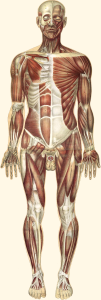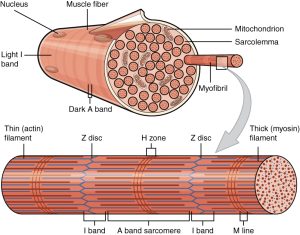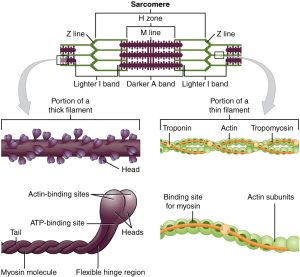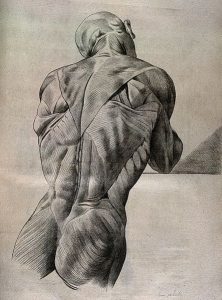Functions of Muscle Tissue
Objective 10.1
10.1.1 Describe the overall purpose of muscle tissue.
10.1.2 Define depolarization, action potential, and excitable.
10.1.3 Recognize the proteins found in muscle cells and state their basic function.
10.1.4 Describe the four functions of muscles and give one example of each.
 Almost half of an adult’s body weight comes from muscle, one of the four main types of tissues found in the body. Although there are three different types of muscle tissue, they all share some basic characteristics. Muscle tissue is often referred to as “excitable,” meaning the electrical state of the plasma membrane can change. This change, known as depolarization, occurs in response to signals from the nervous system, endocrine system or as a reaction to various intercellular signaling molecules.. Regardless of muscle tissue type, the end result of depolarization is a shortening of fibers resulting in muscle contraction.
Almost half of an adult’s body weight comes from muscle, one of the four main types of tissues found in the body. Although there are three different types of muscle tissue, they all share some basic characteristics. Muscle tissue is often referred to as “excitable,” meaning the electrical state of the plasma membrane can change. This change, known as depolarization, occurs in response to signals from the nervous system, endocrine system or as a reaction to various intercellular signaling molecules.. Regardless of muscle tissue type, the end result of depolarization is a shortening of fibers resulting in muscle contraction.
Muscle cells, also known as muscle fibers, share many of the same basic structures and functions as other cells. They have nuclei, cell membranes, mitochondria, cytoskeleton, as well as the other organelles found in body cells. They perform metabolism, communicate with other cells and are prone to cell damage and death. The most significant difference between muscle cells and other cells of the body is the density of proteins found within and surrounding the muscle cell. These proteins perform essential functions needed to allow the cell to expand and contract, which is the basis for movement in the body.

The most significant and most abundant constituents of muscle fibers are the contractile proteins actin and myosin. Simply put, myosin proteins pull on actin proteins, resulting in a shortening of muscle fibers, which leads to muscle contraction. The arrangement and specific mechanisms of action between actin and myosin varies between the different types of muscles. Regulatory proteins, troponin and tropomyosin, play a role in preventing some types of muscle contraction in the absence of nervous system stimulation. Structural proteins such as titin, actinin, and nebulin help to connect proteins within muscle fibers and maintain the shape and structure of those fibers, even during contraction. Another protein, dystrophin, serves to anchor the various proteins to the cell membrane and surrounding extracellular matrix. The protein elastin comprises the elastic fibers that are responsible for allowing muscles to stretch up to 1.5 times their resting length and recoil back to their original shape after contraction and relaxation. Many other proteins are found throughout muscles, serving to form channels across cell membranes.

In addition to the proteins found in muscle cells, a variety of ions and other molecules assist in contraction. Sodium and potassium ions allow for the transmission of signals, known as action potentials, across the membrane of the muscle cell. Calcium ions play a critical role in initiating contraction within muscle cells. Molecules like myoglobin, creatine, and adenosine triphosphate (ATP) are all essential for normal muscle maintenance and action.
There are four functions of muscle tissue.
First, and most obviously, muscle tissue is responsible for producing body movements. For example, in the last unit, we discussed flexion and extension, adduction and abduction. These are body movements. Not as obvious, but still important, are the pumping action of the heart carried out by cardiac muscle, and the peristaltic (milking) movements within the digestive tract.
Second, the muscular system stabilizes the body position. Without muscle activity, not just movement would cease; also, the constant battle of the body against gravity would be lost.
Third, muscles store and move substances within the body. For example, digestive enzymes are kept in the pancreas by a specialized circular muscle called a sphincter. When a meal arrives and is detected by the sphincter, it relaxes and releases its cargo of digestive juices. Lymph fluid is pushed around by muscular action, having no pump of its own.
Finally, muscles play an important role in thermoregulation by generating heat. We are only intermittently aware of the heat generated by muscles. When you are cold and start to shiver, you are subconsciously causing contraction of many muscles to generate heat. About 70-80% of the energy used by muscles is lost as heat, so in some ways they are better heat generators than they are movement generators. Normal body movements are responsible for a significant portion of the heat that contributes to the normal body temperature (37°C). There are many stories of individuals who survived extended times in freezing temperatures because they kept moving, which caused their bodies to stay warm.
Media Attributions
- U10-001 Bougle_whole2_retouched © Bouglé, Julien is licensed under a CC BY (Attribution) license
- U10-003 16795-121 © Betts, J. Gordon; Young, Kelly A.; Wise, James A.; Johnson, Eddie; Poe, Brandon; Kruse, Dean H. Korol, Oksana; Johnson, Jody E.; Womble, Mark & DeSaix, Peter is licensed under a CC BY (Attribution) license
- U10-004 1003_Thick_and_Thin_Filaments © Betts, J. Gordon; Young, Kelly A.; Wise, James A.; Johnson, Eddie; Poe, Brandon; Kruse, Dean H. Korol, Oksana; Johnson, Jody E.; Womble, Mark & DeSaix, Peter is licensed under a CC BY (Attribution) license
- U10-005 Drawing of muscles of the back © Gamelin, Jacques is licensed under a Public Domain license

